Introduction to Classification of Computers.
There are various computers available around. These various computers have different functionality depending on data, information processing, and handling abilities.
The processed data and information are further transferred to the CPU, and later, the output is received using the output devices of the computer system.
Classification of Computer According to purpose, size, type, and uses is explained with examples and images.
What is the Classification of Computers?
The computers are classified into three types they are as follows.
- Analog.
- Digital.
- Hybrid.
The computer is considered one of the best inventions of all time.
They are used to store massive amounts of data and information permanently, and the data can be retrieved whenever a user requests or demands.
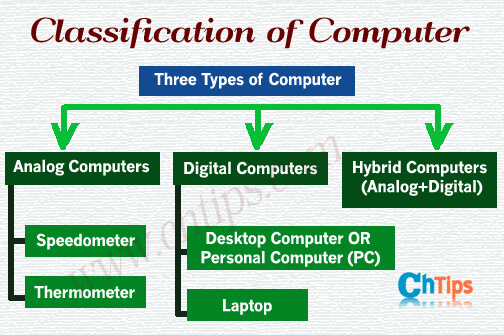
Computer memory stores data like Hard disks and SSD, Pen Drives, CDs, and DVDs. Computer systems are used in our daily life with more speed and convenience.
The computer works with 100% accuracy and efficiency.
Classification of Computer According to Purpose
Computer classification according to purpose can be classified into two different types.
- General Purpose Computers.
- Special Purpose Computers.
General Purpose Computer.
These computer systems are specially designed and developed to work with standard functions and applications of computers.
These computers are multitasking computers, and speedy computers also can save data and information.
These computers are extremely helpful in working with word processing, documenting, creating and editing, playing songs and movies, creating small applications, working with spreadsheets, etc.
These computers are inexpensive compared with special-purpose computers.
General Purpose Computers have less memory and low processing power as they do not have to work with more enormous applications for faster results.
A computer that performs everyday tasks and operations given to them falls in the category of general-purpose computers.
Examples of general-purpose computers are desktops, [PC] Personal computers, notebooks, tablets, etc.
Special Purpose Computer.
These computer systems are designed and developed to perform particular tasks and operations and derive necessary results with great speed, accuracy, and consistency.
These computers have more processing power, storage capacity, and speed than general-purpose computers.
These computer systems allow additional devices and components to connect for better performance and enhanced functionality.
Such a computer’s system configuration can be upgraded anytime when the user needs more functionality and power.
These systems can have multiple CPUs [Central Processing Unit] for more speed and handling power.
They are beneficial in the following departments.
- Scientific Research.
- Military.
- Weather forecasting and Predicting Earthquakes.
- Cryptocurrency Mining.
- Space Science.
Examples of special-purpose computers are
- Super Computers.
- Workstations.
- Servers.
Classification of Computer According to Purpose with Image
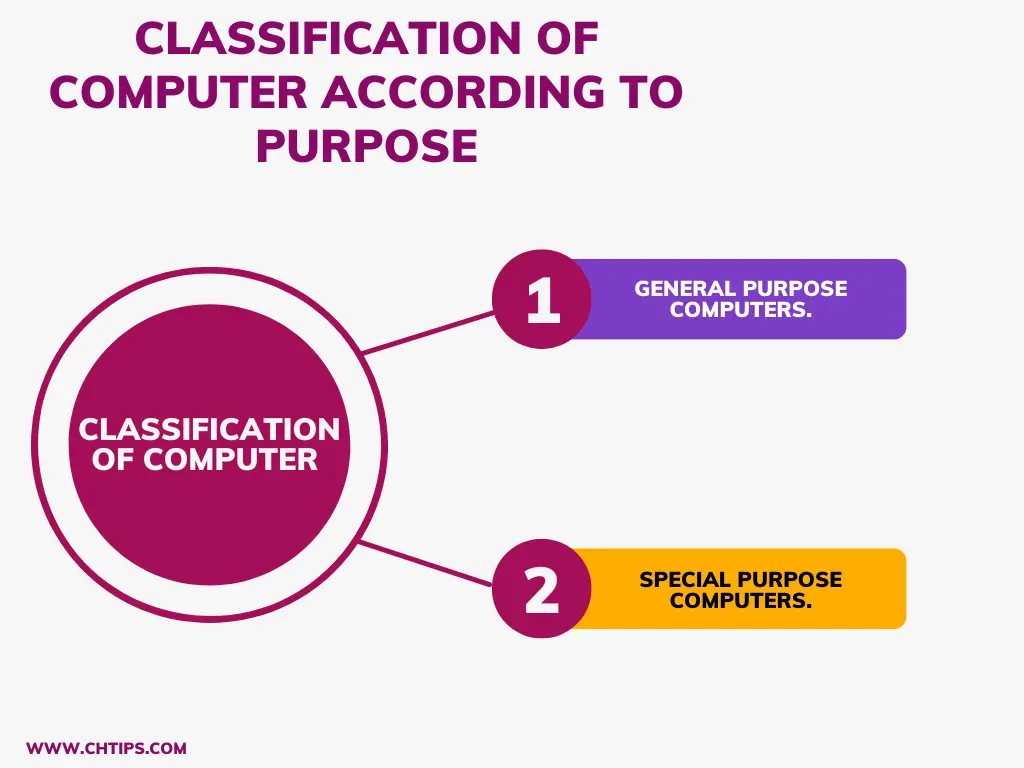
Classification of Computer According to Generation of Computer
The computer can be classified according to the generations of computers.
There are five generations of computers that have immensely evolved during this period.
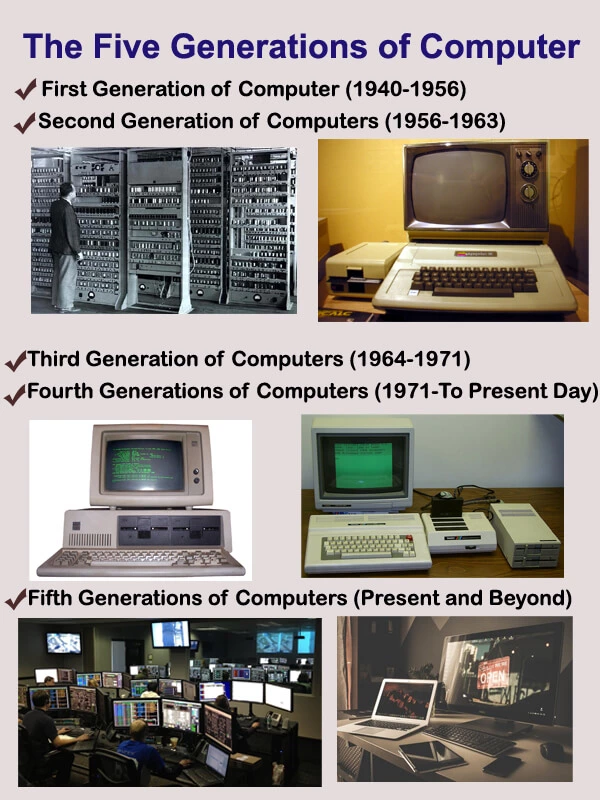
First Generation of Computer.
ENIAC [Electronic Numerical Integrator and Computer] is the first computer designed and developed by John Mauchly, and J. Presper Eckert built the machine at the University of Pennsylvania.
The timeline of the first generation of computers is considered to be 1946. – 1955.
The 1st generation of computers used and utilized vacuum tubes in their circuitry.
First-generation computers were massive in size as they used gigantic vacuum tubes. They also produced a lot of heat and energy.
They needed air conditioners for their devices and components to avoid physical damage like burns from excessive heat.
They also used magnetic drums for data and information storage.
They understood low-level programming language and were developed using “Machine Language” which is also called “Binary language” representing 0s and 1s.
| # | Computer Generations | Timeline | Hardware |
| 1 | First Generation of Computer | 1940-1956 | Vacuum Tubes |
| 2 | Second Generation of Computer | 1956-1963 | Transistor |
| 3 | Third Generation of Computer | 1964-1971 | Integrated Circuit (I.C.) |
| 4 | Fourth Generation of Computer | 1971-1980 | Microprocessor |
| 5 | Fifth Generation of Computer | 1980- Till Now | Artificial Intelligence |
Examples of First-Generation Computers
- ENIAC:: Electronic Numerical Integrator and Computer.
- EDVAC:: Electronic Discrete Variable Automatic Computer
- UNIVAC 1:: Universal Automatic Computer 1
- IBM- 701.
- IBM- 650.
- IBM 650.
- IBM 702.
- IBM 704.
Second Generation of Computer.
The timeline of the second generation of computer systems is between 1956 – 1964. The second-generation computer used a transistor in its circuit.
The transistor was designed and invented in 1947 by three physicians Bardeen, Brattain, and Shockley.
The 2nd generation computer used magnetic core memory for storing data and information. They consumed less electricity compared to the first generation of computers.
They produced less heat and power compared to 1st generation of computers.
They used high-level language, binary language, and assembly language. They are compact compared to the first generation of computers.
RAM [Random Access Memory] and ROM [Read Only Memory] are used for storage.
They are portable and can be shifted from one location to another.
The second generation of computers was used for commercial purposes. They were highly reliable and efficient machines.
They produce accurate output compared to other computers.
They used COBOL, SNOBOL, ALGOL, and FORTRAN languages.
Examples of 2nd generation of the computer system.
- UNIVAC 1108.
- IBM 7094.
- CDC 3600/1604.
- HONEYWELL 400.
Third Generation of Computer.
The third generation of computers uses and utilizes Integrated circuits [I.C.IC] despite vacuum tubes and transistors.
In 1958 Integrated circuits were developed by Jack Kilby.
Several components and segments were used in a single silicon chip, like Transistors, Resistors, and Capacitors.
They were called “Semiconductors” which drastically improved and enhanced the speed, reliability, efficiency, and dependability.
It used binary, assembly, and high-level languages like FORTRAN, COBOL, PASCAL, and BASIC.
Examples of Third Generation of Computer.
- PDP8
- IBM360
- PDP11.
- ICL-2903
- CDC1700
- PDP-11/45
The third generation of computers is multitasking and multi-programming.
Fourth Generation of Computer.
The computer fourth generation timeline is 1970-1985. This computer used a microprocessor instead of an Integrated Circuit [IC].
The microprocessor is also called CPU [Central Processing Unit] or Processor. The microprocessors are considered the heart or brain of a computer.
The microprocessor was developed by Federico Faggin, Marcian Hoff, Stanley Mazor, and Masatoshi Shima in 1971.
The microprocessor can carry out trillions of instructions per second.
The main functions of the microprocessor are arithmetic and logical unit, Control unit, and cache memory.
The microprocessor enhanced the speed and accuracy of the computer system. It also improved performance and functionality.
They produce less amount of heat and consume less electricity.
These computers used real-time, time-sharing, and distributed operating systems.
4th generation computers used high-level languages like C, C++, Java, PHP, etc.
Examples of Fourth Generation of Computer.
- Micral
- IBM 5100
- Altair 880
- DEC 10
- STAR 1000
- PDP 11
- CRAY-1(Super Computer)
- CRAY-X-MP(Super Computer)
- CRAY2
- CRAY Y-MP
- CRAY Y-MPC
- IBM 4341
- IBM PC
- Apple II
- VAX 9000
Fifth Generation of Computer
Fifth-generation computers use AI [Artificial Intelligence] and microprocessors for better performance and enhanced functionality.
These computers are incredibly faster and almost permanently store vast amounts of data and information.
They use high-level languages like C, C++, Python, and PHP.
These computers are portable and can be shifted from one location to another.
They are versatile, multi-programming, multitasking machines that perform every task with great accuracy and incredible reliability.
These machines / Computers will be intelligent computing devices as well as they will be smart machines.
The fifth-generation computers will learn independently and communicate with humans with the help and assistance of languages, pictures, signs, speech, and writing.
They will possess huge memory storage and can take action when given commands.
These machines are used in voice recognition systems like Google Assistant, Alexa, and SIRI.
- PARAM 10000
- INTEL IPSC-1
People Are Also Reading
- Advantages and Disadvantages of Computer
- 10 Uses of Computer in Different Fields With Pictures
- The Five Generations of Computer
- A Brief History of Computer System
- Classification of Computer System
- What is CPU in Computer
- What is a Supercomputer and its Uses
- Four Basic Functions of Computer
- Different Types of Computer System
- What is a Computer Virus & Their Types
- Computer Hardware and Software with Examples
- What is a Computer Memory
- Five Basic Components of Computer
- Advantages and Disadvantages of Desktop Computers
- Types of Pointing Devices
- What is a Computer System and its Types
- Different Characteristics of Computer
- 10 Symptoms of Computer Viruses
- Computer Basic Tutorials
Classification of Computer According to Size and Application
Computer classification according to size and application can be categorized into four different types mentioned below.
- Micro Computer.
- Mini Computer.
- Mainframe Computer.
- Super Computer.
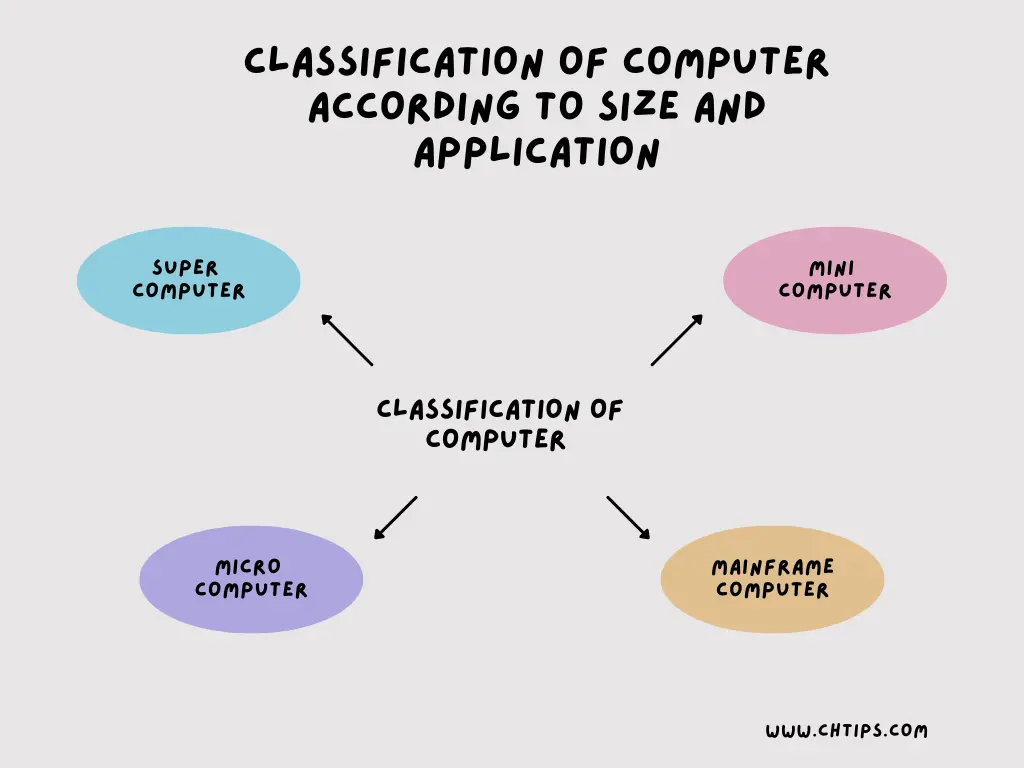
Super Computer.
Supercomputers, with excellent storage capacity, are considered the fastest computer in data processing and handling.
They are big and may have multiple CPUs [Central Processing Units] for faster data and information access.
The supercomputer also uses parallel processing for better functionality, performance, and processing.
A speed is measured or counted in “FLOPS” (Floating Point Operation per Second). It can perform a speed of over 1 billion per second.
The supercomputer is designed and developed for special purposes like
- Scientific Research.
- Weather Research
- Weather Forecasting
- Military and Defense
- Genetic Engineering
- Nuclear Engineering
- Solving complex numerical problems
- Animated Graphics
- Quantum physics
- Physics simulations
- Airlines
- Data Mining
- Large Database
Examples of Super Computer
- Summit IBM
- IBM Power System Ac992
- Sierra IBM.
- Power System IBM.
- Sunway Taihu Light
- Sunway MPP NRCPC
- Tianhe-2A TH-IVB_FEP NUDT
- Frontera Dell C640 Dell EMC
- Piz Daint CrayXC50 Cray
- Trinity Cray XC40 Cray
- Super MUC-NG
- Think System SD530 Lenovo
- Lassen IBM Power System IBM
Supercomputers are faster machines and emit lots of heat and energy.
Therefore, it is mandatory to use an air conditioner to keep the devices and components of the computer cool and avoid physical damages like burning and overheating.
The supercomputer work and manages applications with tremendous speed. The supercomputer is a million times faster than the mini, mainframe, and microcomputers.
The supercomputer’s speed is because of thousands of processors installed on them that make them extraordinary.
Mainframe Computer.
They are small in size compared to a supercomputer. Mainframes are fast and can store a massive amount of data and information.
They have extremely impressive data processing and handling abilities, and hence the number of users can connect to them quickly for better data sharing and functionality.
Mainframe computers can connect to another microcomputer to form a network.
They support tens of thousands of remote computers and can work as a “Host Computer”; they are pretty good when considering working with different operating systems.
They can store data and deliver millions of instructions and guidelines per second.
Uses of Mainframe computers
- Banking.
- Government Databases.
- Airline and Railway Reservation.
- Population Database.
Some Examples of Main Frame Computer are as follows:
- IBM Z890.
- Hitachi’s Z800.
- CDC Cyber Series.
- IBM 4381.
- ICL39 Series.
Mini Computer.
Minicomputers are considerably smaller in size compared to supercomputers and mainframe computers.
Minicomputer consists of more than 1 CPU [Central Processing Unit], making them faster than microcomputers and costlier than microcomputers.
Mini computers work slower than mainframe computers.
Minicomputers are called "Workstations" or "Midrange Computers".
Mini computers are extensively used in small businesses and medium-sized companies.
Examples of Minicomputers.
- Micro VAX
- PAP1
- IBM OS/400
- VAX
- Texas Instrument TI-990
The powerful minicomputer is called a "Super-Minis".
Micro Computers.
Microcomputers are compact in shape and size and use a microprocessor, processor, or CPU for processing and calculations.
They are comparatively relatively smaller than other computers.
The microprocessor is cheaper than the technology used by [Mini, Mainframe, and Super].
This computer can be accommodated inside a briefcase and placed on a desk. Therefore these tiny computers are called “Microcomputers“.
The microprocessor is also called CPU [Central Processing Unit] or Processor.
The microprocessors are also known as the heart or brain of a computer.
The primary function of the microprocessor is to perform arithmetic and logical operations at high speed with great accuracy.
Microcomputers can perform trillions of operations per second.
There are different types of microprocessors they are as follows.
- Dual Core Processor.
- Triple Core Processor.
- Quad Core Processor.
Microcomputers are also called “Personal Computers” [PC].
These are personal computers at low cost, and users can purchase them from the market.
They are extensively used and utilized in small businesses for file handling, word processing, and spreadsheets, and they are also called general-purpose computers.
They can perform multiple tasks simultaneously.
Uses of Microcomputers.
- They are personal or home computers, abundantly used in our daily activities.
- They can comfortably work in the banking sector.
- Small shops.
- Shopping Malls.
Classification of Computer According to Type
The classification of computers according to type can be classified as below.
- Analog Computer.
- Digital Computer.
- Hybrid Computer.
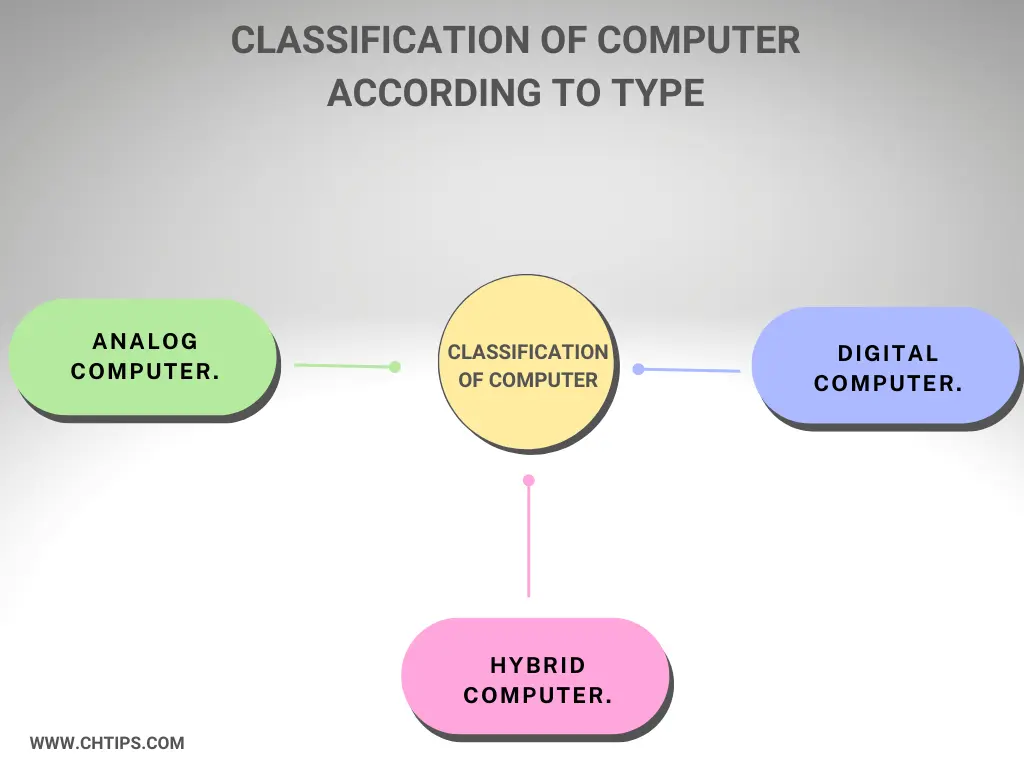
Analog Computer.
Analog computers are that computer that works with physical quantities like length, current, height, temperature, pressure, and voltage.
Analog computers were used in science and engineering.
Analog computers are designed and developed to measure things despite checking and counting.
Some Examples of Analog Computers.
- Operational Amplifiers.
- Mechanical integrators
- Slide rules.
- Tide Predictors
- Electric Integrators
- Thermometer
- Speedometer
- Seismometer
- Voltmeter
- Flight Simulators
Digital Computers.
Digital computers are those computers that calculate numbers and digits.
Today, analog computers are almost obsolete, and digital computers are used and utilized globally.
These computers convert 0s and 1s to digital format. In other words, convert them into human-readable form.
Examples of Digital Computers
- Digital Clock.
- Calculator.
- Weighing Machine.
- Consumer Electronic Equipment.
- Laptop.
- ATM Machines
- Smart Phones.
- Automobiles.
Hybrid Computer.
Hybrid computers are a combination of analog computers and digital computers.
They possess all the qualities of both analog and digital computers.
Examples of Hybrid Computers.
- Gasoline Station
- Electrocardiogram Machine
- Monitoring Machine
- Ultrasound Machine
Useful Video On: Classification of Computer
Computer Classifications PDF Download
Classification of Computer According to Use
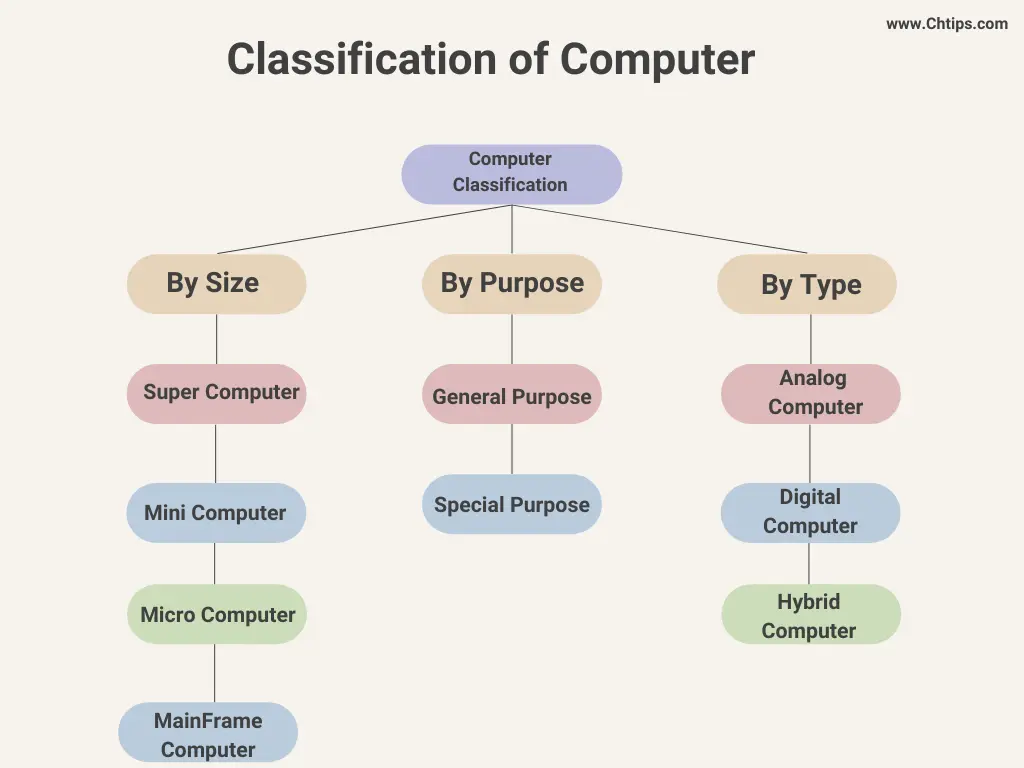
Types of Classification of Computer
- Analog Computers.
- Digital Computers.
- Hybrid Computers.
Classifications of Computer According to Technology
A computer is a tool that can process and handle data and information.
They are used in various sectors like business, home, education, and personal use.
There are different types of computers available in the market.
They all may look the same, but still, there can be a huge difference in their configurations and specifications.
Choosing a computer that suits your need is a tedious task, but this can be made easy.
If a user is aware of the basic understanding of how a computer works and understanding of computer hardware and software features.
The computer system consists of two main parts that are:
- Hardware.
- Software.
Computer Hardware Devices.
Various hardware devices in computer systems are used and utilized for different purposes. Some of the important hardware devices are mentioned below.
5 Examples of Hardware Devices.
- Central Processing Unit.
- Motherboard.
- Random Access Memory [RAM].
- Hard Disk Drives.
- Monitors.
Before buying | or purchasing a new computer system, you must look at the Processor and memory installed in the system.
The CPU | Processor is the heart of the computer system, and it is also responsible for the speed at which it performs operations and instructions given to them.
A more powerful Processor will operate speedier.
Therefore, it is highly recommended to choose a powerful processor to reap more benefits from your system.
RAM [Random Access Memory] is an important device that plays a vital role in computer speed.
The RAM capacity to process data and information can eventually determine the computer’s speed.
The computer systems classified according to hardware are called “Hardware level classifications”.
Lastly, pay more attention to which system software is installed on the computer.
System software is called an “Operating System”.
The more advanced operating system can help users derive the latest and updated results. The advanced and latest operating systems are compatible with the latest and huge software applications.
The common operating systems are:
- Windows.
- Linux.
- MAC.
Different specification computer systems are developed for photo editing, video editing, and gaming.
A simple configuration computer can be used and utilized when working on spreadsheets, word processors, and daily routine work.
The computer system classified according to the software is called “Software level classifications”.
| Classification of Computer According to Purpose, Size, Types, and Uses Free PDF Download | Download |
5 Types of Computer Systems
There are different types of computer systems that are mentioned below.
- Super Computer.
- Mainframe.
- Mini Computer.
- Server Computer.
- Workstation Computer.
- Personal Computer or PC.
Super Computer.
Supercomputers are considered the fastest and speedy computers compared to their counterparts.
They have prominent and massive storage capacity.
Their speed is measured in “FLOPS” (Floating Point Operation per Second). It can perform a speed of over 1 billion per second.
Some Examples of Super Computers are
- PARAM 10000.
- IBM Deep Blue.
- Tianhe-2.
Mainframe.
They are huge, expensive, and speedy computers, compared to mini-computers, but less fast than supercomputers.
They can save an incredible amount of data and information.
Examples of Mainframe Computers.
- IBM Z890
- Hitachi’s Z800
Mini Computer.
The mini-computers are also called "Midrange computers" or "Mini".
These are multi-user computers, meaning multiple users can connect to these computers for better performance and functionality.
DEC [Digital Equipment Corporation] developed PDA-1[Programmable Data Processor-1], which started mini-computer development.
Examples of Mini Computers.
- BM’s AS/400e
- Honeywell200
- TI-990.
Server Computer.
This computer system uses a database where data and information can be accessed very quickly.
Other computers can easily connect to the server with the help of computer networking.
Examples of Super Computer.
- Cray Titan.
- NUDT Tianhe-2.
- IBM Sierra.
Workstation Computer.
The workstation computer is designed and developed for professional work.
These computers are used and utilized for computational and graphical uses.
Personal Computer or PC.
Personal computers are called" PC". They are also known as "Desktop Computers".
This computer uses a microprocessor for better performance and functionality.
10 Characteristics of Computer System
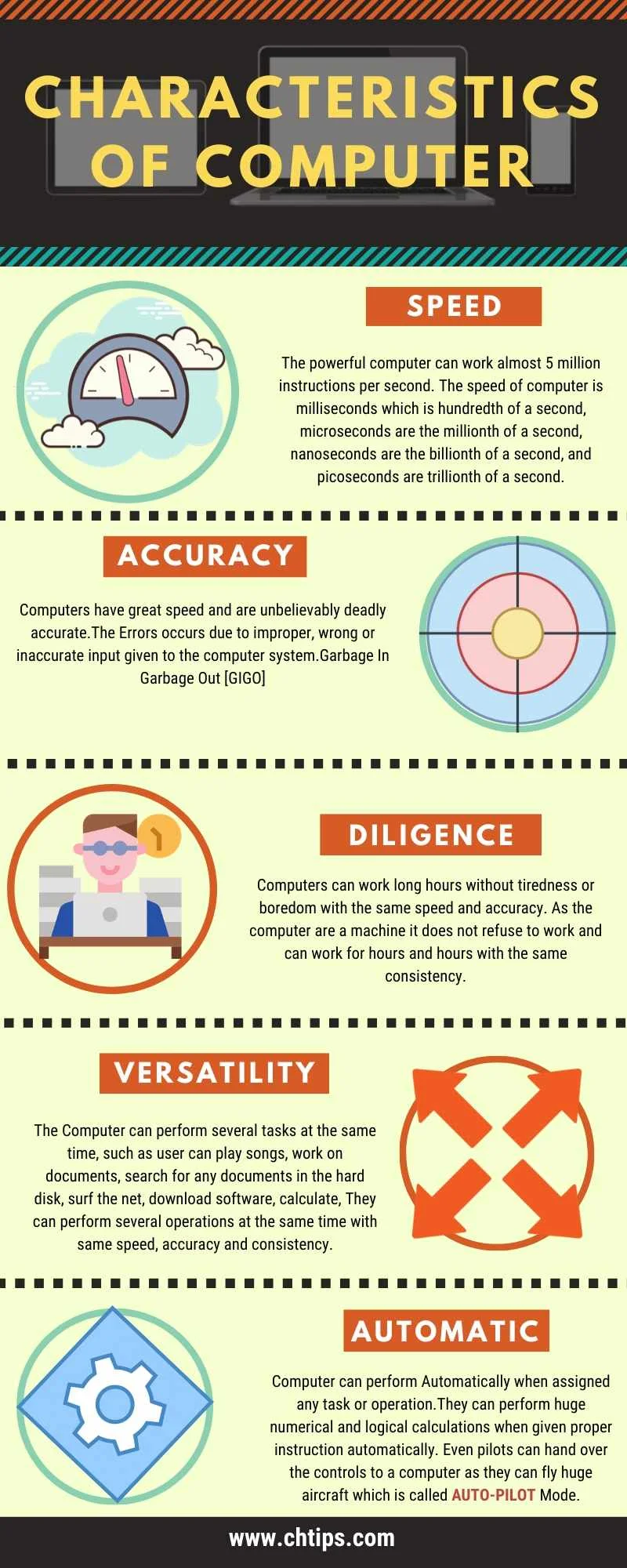
A computer system is used, utilized, and accepted globally because of the significant characteristics of a computer.
- Speed.
- Accuracy.
- Automation.
- Versatility.
- Diligence.
- Reliability.
- No Feeling, No IQ.
- Memory.
- Privacy and Security.
- Multitasking.
1. Speed.
A computer speed is measured or calculated in MIPS [Millions of Instruction Per Second]. It is a speedy device that can perform and execute complex and tedious calculations at a very high speed.
2. Accuracy.
Not only speed, but computers can also perform with fantastic accuracy. Computers are reliable machines that are trusted worldwide for obtaining derived results with speed and 100% accuracy.
3. Automation.
A computer can perform in automation mode. The computer system can achieve the same task and operation without human intervention when given a specific command or request.
4. Versatility.
Computers can perform several and numerous tasks and operations at a single time. Some functions are playing songs, editing and writing documents, and playing games simultaneously.
5. Diligence.
Computers can work non–stop without feeling boredom, laziness, and tiredness. The system can work with the same speed and accuracy with the same intensity.
6. Reliability.
A computer is a reliable machine. The outputs that are produced by computers are more reliable and trustworthy.
7. No Feeling, No IQ.
They do not have feelings and self-IQ. They do not feel anything unlike humans, i.e., tiredness, boredom, laziness, envy, or jealousy.
8. Memory.
Computer systems have a fantastic memory and can permanently save and store vast amounts of data and information.
9. Privacy and Security.
Password protection can secure the data and information inside the computer system.
10. Multitasking.
The computer can perform multi-task using the operating system. An operating system installed in a computer system can perform multiple operations and multiple tasks at once.
5 Advantages and Disadvantages of Computer System
The computer is considered one of human history’s greatest inventions. The importance of computers can be seen in everyday life.
The computer has changed the overall working function of our day-to-day life.
There are numerous advantages and disadvantages of the computer system that we are going to learn in this section of the article.
5 Advantages of Computer System
- Speed
- Accuracy
- Stores Huge Amount of Data
- Online Trading
- Online Education | Distance Learning
- In Business
Speed.
A computer system can perform given tasks, jobs, and operations with fantastic speed. It can perform tedious and complex mathematical problems and equations with speed.
It is a multitasking machine and can handle and execute millions and millions of operations at a single time.
The speed of the computer is measured in picoseconds.
The speed of a computer depends upon some hardware components, which are Processor, RAM, and Motherboard.
Accuracy.
Computer systems can present output when the input is processed with speed and almost 100% accuracy.
The output entirely depends upon the accuracy of the input given to the system. Users can rely on the output computer present as they are more reliable and efficient.
Stores Huge Amount of Data.
The computer system has external storage devices like Hard disks, Pen drives, CDs, and DVDs.
This type of non-volatile memory means the data and information are not erased or lost when there is no power or even a computer and the laptop is shut down.
The storage capacity of the Hard Disk is measured in GB [Giga Byte] and TB [Tera Byte].
Online Trading.
A computer has helped immensely the user working in the share market and online trading. A computer with an internet connection is handy in online shopping.
E-commerce websites and online trading cannot be done without computers and the internet.
Online Education | Distance Learning.
The internet is full of knowledge and information.
You must work on the internet with a computer system to acquire this.
Students can learn and grab skills and expertise from any reputed institute at their own pace and convenience.
YouTube is also one of the accessible sources of information and knowledge, one of the most websites with Google.
5 Disadvantages of Computer System
- Health Issues.
- Spread of Pornography
- Virus and Hacking Attacks
- Spread of Violence and Hatred
- Online Cyber Crimes
1. Health Issues.
Using a computer for long hours without taking ample rest can harm your body badly; you may see a difference in vision, your digestion may get weakened, less physical exercise can make your body cramp, and many more.
2. Spread of Pornography.
This is the most significant disadvantage of computers, as porn websites can easily access without restrictions.
Students are losing their precious time visiting such websites, also destroying their moral duties.
3. Virus and Hacking Attacks.
This is the biggest threat to computer as hackers, crackers, and spammers try to steal your sensitive information by tricking a user into clicking or downloading specific files from the internet that contains viruses.
Phishing attacks are more common nowadays; therefore, users are advised to use legal antivirus and malware protection software.
Users should not visit unauthenticated websites and applications for download.
4. Spread of Violence and Hatred.
The information and news, whether genuine or fake, can quickly spread over the internet.
Therefore, it is highly suggested that users should get a fact check regarding the information and article before sharing any articles and news.
5. Online Cyber Crimes.
Online fraud and crimes are more common these days. Hackers and spammers look for vulnerabilities in the computer system.
What are the 6 Types of Computers According to the Purpose?
| 1 | SuperComputers. |
| 2 | Analog Computers. |
| 3 | Digital Computers. |
| 4 | Hybrid Computers. |
| 5 | Server & WorkStations. |
| 6 | MainFrame Computers. |
Generations of Computer 1st to 5th
| # | Computer Generations | Timeline | Hardware |
| 1 | First Generation of Computer | 1940-1956 | Vacuum Tubes |
| 2 | Second Generation of Computer | 1956-1963 | Transistor |
| 3 | Third Generation of Computer | 1964-1971 | Integrated Circuit (I.C.) |
| 4 | Fourth Generation of Computer | 1971-1980 | Microprocessor |
| 5 | Fifth Generation of Computer | 1980- Till Now | Artificial Intelligence |
History of Computer
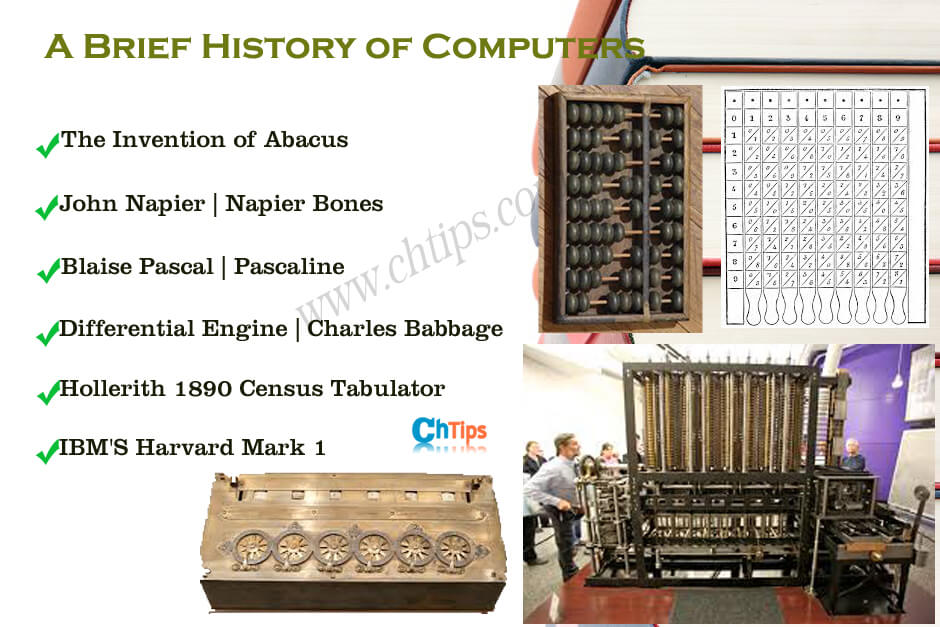
A Chinese engineer designed and developed the first computer in 2400 BC.
This is considered to be a mechanical device that was used and utilized for calculation.
Abacus is a device made of a wooden frame that uses a metal rod with 9 bars vertically and 1 pole horizontally, and each pole bears around 7 beads.
The bar was partitioned into 2 portions, upper and lower. The upper portion consists of 2 beads, and the quieter consists of 5 beads.
The upper portion with 2 beads represented as number 5, and the lower part with 5 beads was a single or solitary unit.
Before the abacus was developed, people of that age did the calculation with fingers or stones.
ABACUS stands for Abundant Beads, Addition, and Calculation Utility System
John Napier | Napier Bones.
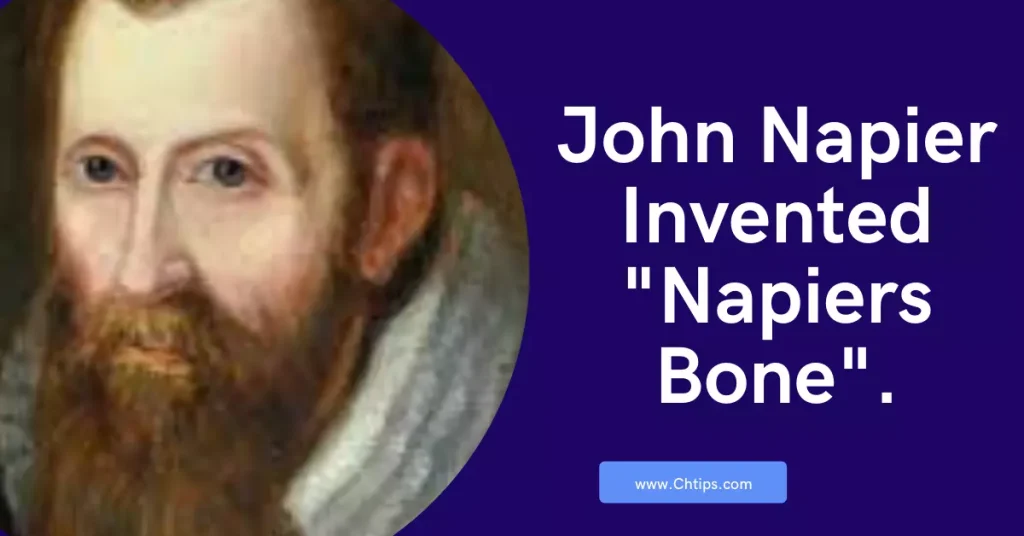
John Napier was a scientist from Scotland who designed and developed Napier Bone in 1617. This device is a mathematical device used and utilized for calculation.
Napier Bone is a mechanical calculating device that uses addition and expansion to calculate multiplication.
The device is made of bones and is therefore named “Napier Bones”.
Blaise Pascal | Pascaline.
A French mathematician named Blaise Pascal 19 years ago designed and developed mechanical computing and calculating machine known as “Pascaline” in 1962.
The machine had several teeth and wheels associated with chains. There were 2 models; one was 6 wheels, and the other was 8 wheels.
Differential Engine | Charles Babbage.
In 1822 English philosopher, mathematician, and scientist name Charles Babbage invented a machine name “Differential Engine”.
Charles Babbage also designed and developed an automatic computing mechanism called the “Analytic Engine”.
The Analytical engine was able to store the information and data in its memory.
Charles Babbage is called as "Father of Computer".
Hollerith 1890 Census Tabulator.
Herman Hollerith, a German mathematician, created and invented the tabulating machine utilizing punch cards for registration in the USA,
The cards used to have gaps; when the cards went through machines, the machine distinguished the gaps, and afterward, the device could recognize the numbers and later, the device could make necessary calculations.
IBM’S Harvard Mark 1.
The Harvard Mark I and the ENIAC are both Historical Computers that have implied an incredible arrangement to advance in the field of current PC history.
It was the first generation of computers and was called an Automatic Sequence Controlled Computer (ASCC).
Functions of Computer
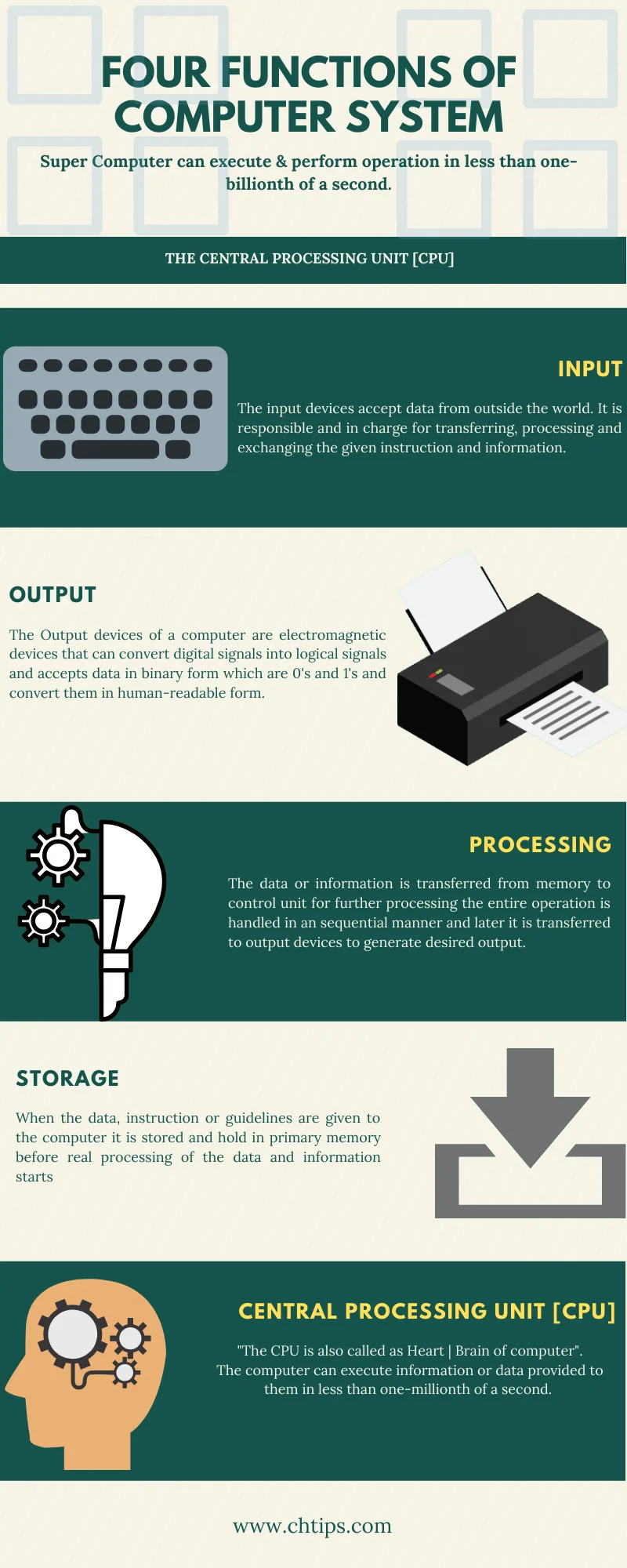
Computer systems are considered the most reliable and efficient devices used globally.
In today’s generation, computers are used extensively in daily routine; with computers’ help, complex and tedious jobs and tasks can be done with just a few clicks.
Computers are speedy machines and devices that can perform any task with unbelievable speed and save and store data and information permanently.
The computer system is designed and developed to perform specific tasks and jobs.
Some significant functions of a computer system are speedy data and information sharing and transfer, solving problems, accuracy, etc.
The four functions of a computer system are
- Input.
- Processing.
- Output.
- Storage.
Let us discuss each function of the computer in detail. Let’s start.
Input.
The computer can work with accuracy until and unless the data and information given to them are accurate and appropriate.
let’s say the data provided to the computer system is wrong or inaccurate; obviously, the result derived with the help of input will eventually be wrong.
This is called "GIGO," which stands for Garbage In, Garbage Out.
The input is given to the computer system with the help of input devices of the computer system.
- Keyboard.
- Mouse.
- Scanner.
- Trackball.
- Joystick.
- Light Pen.
- Touch Screens.
- Optical Card Reader (OCR)
Keyboard and mouse are considered to be one of the computer system’s most used and popular input devices.
The data entered through these input devices are processed in the computer system for further processing.
These data are processed for output with the help and assistance of output devices of computers like printers and monitors.
The data and information are collected by input devices from outside the world into the computer for processing and handling.
The primary function of a computer is to provide output to the user after processing the input using a central processing unit.
Processing.
In this process, the input received from the input devices of the computer is transferred to the processing unit for processing and handling.
This process decides the nature of the output that will derive after processing is done.
The data and information given to the computer system are transferred from the memory to the control unit for further processing and handling to derive output in human-readable form.
This process of processing data and information is done with the help of a processor [CPU] [Central Processing Unit].
The processor is primarily responsible for the speed and accuracy of computers.
The processor is also called as "Brain of Computer".
The CPU is also responsible for handling the Control Unit, Arithmetic and Logic Unit, and Memory Unit.
Processing is considered to be the core function of the computer system.
Output.
After the processing is done, the output functions come into play. The result received after processing the data is displayed on the output devices of the computer.
Some of the popular devices of computers are
- Printers.
- Monitors.
- Speakers.
The output received from output devices mainly depends upon the computer’s speed; therefore, the CPU comes into the picture, as the computer speed depends upon the processing power of the processor.
Storage.
The output received on the computer screen or printer can be saved or stored permanently in the storage devices of the computer.
There are 2 types of storage, and they are as follows.
- Internal Memory or Primary Memory.
- External Memory or Secondary Memory.
Internal Memory or Primary Memory.
The prime examples of primary memory are
- RAM [Random Access Memory].
- ROM [Read Only Memory].
- Cache Memory.
The primary memory is called "Semiconductor Memory".
They are a type of volatile memory because they tend to lose the data and information when there is a power failure or the computer system is shut down.
The internal memory is comparatively faster than the secondary memory.
They are expensive, faster, and consume less power and energy. This memory is the core architecture of a computer system, as the system cannot perform or start if the memory is missing.
External Memory or Secondary Memory.
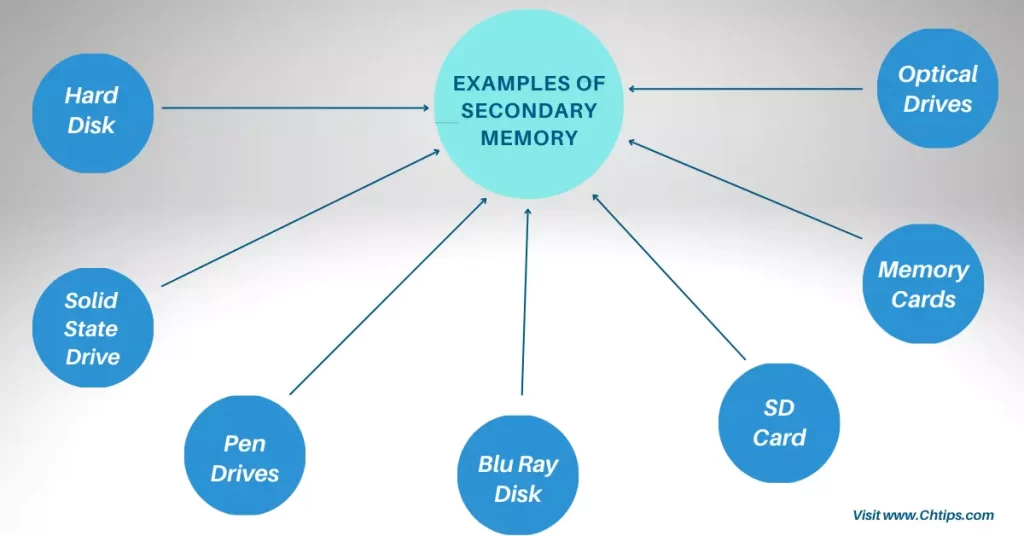
The external memory of a computer system is slower than internal memory.
They are non-volatile memory as they cannot erase or lose data and information even if there are no power, electricity, or computer shutdowns.
The external memory can save data permanently, and the user can retrieve the information whenever the user request or demands it.
Some Examples of Secondary Memory are as Follows.
- Hard Disk
- Solid-State Drive
- Pen Drive
- Blu Ray Disk
- SD Card
- CD Drive
- DVD Drive
- Memory Cards
- Floppy Disks
- Disk Packs
- Paper Storage (Punched Tapes, Punched Cards)
- Magnetic Tapes
Cache Memory.
They are a type of volatile memory. They are significantly faster memory that is embedded near the processor.
The cache memory is the fastest memory available, and it acts as a buffer between RAM and the CPU (Central Processing Unit).
Importance of Computer System
The computer system’s development is considered one of the stepping stones toward the development of humankind.
The computer can perform arithmetic and logical calculation with tremendous speed and accuracy.
Computer memory can store an incredible amount of data and information permanently.
Computers’ most significant feature and characteristic is solving complex problems at fantastic speed.
They are capable of solving complicated mathematical problems.
Computer systems are extensively used in offices, hospitals, malls, schools, colleges, universities, banking, etc.
The computer with an internet connection has entirely changed the education sector. The way students learn and gain skills and knowledge with the help of a laptop is pretty impressive.
Schools, colleges, and universities are using a computer system with great benefits like making the student registration process very simple, displaying results, tracking information about students at their fingertips, etc.
E-learning and distance learning are the most significant advantages of computer systems, as students can learn new things at their own pace and convenience.
The knowledge and information can be received in just a few clicks, which is an excellent way of learning new things and stuff globally.
The internet also helps in better communication; one person can get in touch with another person at any time or place.
Email and video calls are such features that have gained popularity over the years due to their simple interface to learn and execute.
Computers are beneficial and essential while searching for jobs worldwide; also, the interviews can be conducted online conveniently.
Work from home can only be achieved with the help of computers …. Big thanks to the computer system.
The businesses are done with the help of personal computers and laptops to avoid various issues and speedy processing of data and information that eventually helps spread the company and make profits.
The importance of computers can be witnessed when working on a PC in our daily routine. Some such activities are given below.
- Banking.
- Social Media
- Online Shopping.
- Paying Bills.
- Video Calling.
The importance of computers can be seen while working on
- Share Market.
- Business.
- Education.
- Medicines and Treating Patients.
- Scientific Research.
- Military.
Frequently Asked Questions [FAQs] on Computer Classifications
What are the Categories of Computer Systems?
The computer systems are categorized as follows.
1] Mini Computers.
2] Micro Computer.
3] Mainframe Computers.
4] Super Computer.
5] Server or Workstation.
Who Discovered Computer Systems?
The computer system was designed and developed by an English mathematician and inventor named Charles Babbage.
Charles Babbage is also known “Father of Computer”.
When Was First Computer Developed by?
The world’s first personal computer was named “Kenbak-1” in 1971. It was designed and developed by John Blankenbaker of Kenbak Corporation.
What was the First Computer Called?
The First digital computer was called “Atanasoff–Berry computer or ABC”.
Classification of Different Types of Computer Systems?
The computer system is categorized into four different types.
1] Super Computer.
2] Mainframe.
3] Mini.
4] Micro.
3 Classification of Computer System
1] Analog.
2] Digital.
3] Hybrid.
The Five Generations of Computer Systems
1] First Generation of Computers 1940-1956.
2] Second Generation of Computer 1956-1963.
3] Third Generation of Computer 1964-1971.
4] Fourth Generation of Computers 1971-1980.
5] Fifth Generation of Computer 1980- Till Now.
Functional Unit of Computer System
1] Input.
2] Output.
3] Memory.
4] Arithmetic & Logic Unit.
5] Control Unit.
What are the Three Purposes of a Computer?
The major three purposes of computers are:-
1] Data Processing , Storage and Handling.
2] End to End Communication and Data Retrieval.
3] Entertainment, Educations and Research.
What is the First General Purpose Computer?
The ENIAC [Electronic Numerical Integrator And Computer].
Who is the Father of Supercomputer?
1] Seymour Cray.
2] Boris Babayan.
Who is known as Mother of Computer?
Ada Lovelace was known as the Mother Of Computer.
Get In Touch
I have also written and compiled some articles on computers and telecommunications, and please go through them.
I hope you will like reading it.
I hope all the questions and queries related to the Classification of Computer According to Purpose, Size, Type, and uses With Examples have been answered here.
Don’t hesitate to contact me, and if you need to add, remove or update anything from the article, please let me know in the comment section or via Email.
I will be more than happy to update the article. I am always ready to correct myself.
I was hoping you could share this article with your friends and colleagues; this motivates me to write more on related topics.
!!! Thank You !!!
Comments are closed.